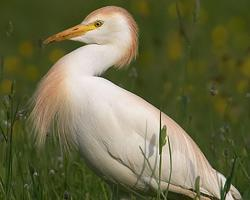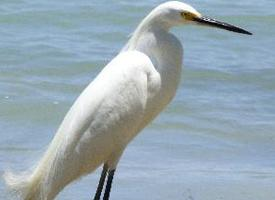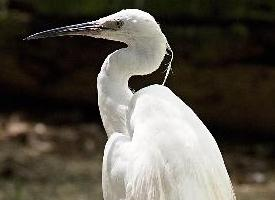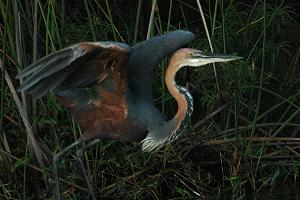
Poids et mesures
| Longueur | de 45 à 56 cm |
|---|---|
| Poids | de 270 à 400 g |
| Envergure des ailes | de 88 à 96 cm |
Statut de conservation
| Intrépide |
Description de l'animal
The Cattle Egret (Bubulcus ibis) is a small, stocky species of heron that is distinguished by its distinctive breeding plumage, which includes patches of buff or orange on the head, chest, and back. Native to parts of Asia, Africa, and Europe, this bird has undergone a remarkable expansion in range over the past century and is now found in many parts of the world, including North and South America, thanks to its adaptability and opportunistic feeding habits.Typically measuring between 46 to 56 centimeters in length, with a wingspan of 88 to 96 centimeters, the Cattle Egret possesses a relatively short, thick neck and a stout bill. In its non-breeding plumage, the bird is predominantly white, with a pale bill and legs that can range in color from yellow to red. During the breeding season, however, it undergoes a striking transformation, developing richly colored orange-buff plumes on its head, neck, and back, while its bill, legs, and irises may turn a vivid red.
One of the most fascinating aspects of the Cattle Egret is its feeding behavior. Unlike other herons and egrets that primarily hunt in wetlands, the Cattle Egret is often found in dry fields and pastures. It has formed a unique symbiotic relationship with large mammals, particularly cattle and other livestock, feeding on the insects and small vertebrates that are disturbed as these animals move through the grass. This behavior not only exemplifies the bird's adaptability but also highlights its importance in controlling pest populations, benefiting both agriculture and natural ecosystems.
Cattle Egrets are highly social birds, often seen foraging in groups. They are also colonial nesters, building their nests in close proximity to one another in trees or shrubs near water bodies. These nests are constructed from sticks and are reused and added to each breeding season. The female typically lays 2 to 5 pale blue eggs, which are incubated by both parents for about 23 days. The chicks are altricial, meaning they are born blind and featherless, and depend entirely on their parents for food and protection.
The global success of the Cattle Egret is partly due to its remarkable ability to exploit new habitats, including those altered by human activity. However, this adaptability has also led to concerns about its potential impact on native species in areas where it has been introduced. Despite these concerns, the Cattle Egret remains a symbol of adaptability and resilience, thriving in a wide range of environments and forming an integral part of the ecosystems it inhabits.
Conservation status-wise, the Cattle Egret is currently listed as Least Concern by the International Union for Conservation of Nature (IUCN), reflecting its wide distribution and large, stable population. Nevertheless, like all species, it faces threats from habitat loss and environmental changes, underscoring the importance of continued monitoring and conservation efforts to ensure its survival.
Animaux similaires
Nouvelles photos d'animaux
Top 10 des animaux
- Dolphin gull (Leucophaeus scoresbii)
- Diana monkey (Cercopithecus diana)
- Moustached guenon (Cercopithecus cephus)
- Galápagos tortoise (Geochelone nigra complex)
- Japanese macaque (Macaca fuscata)
- Russian tortoise (Testudo horsfieldii)
- Stone loach (Barbatula barbatula)
- Greek tortoise (Testudo graeca)
- Common flying dragon (Draco volans)
- Vendace (Coregonus albula)


